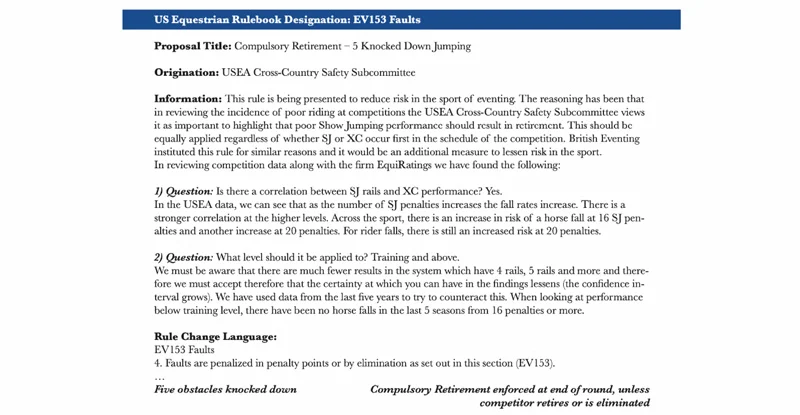Ever had a show jumping round that ended with the ring crew playing a game of pick-up sticks?
Eventers often discuss how to know when to call it a day on cross-country, but sometimes they shrug off multiple rails in show jumping: “Oh, he just knows they fall down.”
A rule change proposal presented at the U.S. Eventing Association’s virtual convention on Dec. 8 addressed multiple rails in show jumping as a safety issue.
Modeled after a rule already in effect in the United Kingdom, a change to EV153, Faults, would make compulsory retirement the penalty for having five rails down.

A change to EV153 would mean compulsory retirement for a rider who has five rails down in show jumping.
The rule change was discussed at last year’s board of governors meeting after Irish statistics company Equiratings found a correlation between a high number of rails down and falls on cross-country.
“Because the officials are so busy doing other things during the day, they may say they’re going to watch a rider go out of the start box, but that TD may not be able to keep watching that,” said USEA President Max Corcoran at last year’s meeting. “This takes the emotion out of it.”
Refusals aren’t taken into account in this version of the rule change.
ADVERTISEMENT
“The English rule refers to penalty points, so in fact, refusals would be part of the criteria to eliminate a horse,” said Malcolm Hook, the forum moderator and USEF Eventing Rules Working Group chair. “My thinking is twofold—one, given that the sport is changeable, if the number of penalty points for a rail changes in the future, then the rule would have to be rewritten. And the other is that to my mind, a horse that refuses to jump a fence that got in wrong is a lot safer than a horse that tries to crash its way over the top of the fence when it goes wrong on cross-country. I don’t see the two as being necessarily the same thing. Years ago in the jumpers back in the ’70s, a refusal was fewer points than a rail, and that comes from the thinking that a horse that jumps something that it can’t get over is more dangerous than a horse that says, ‘No, I’m not going to jump it.’ ”
If passed, the rule would be in effect for training level and above.
Other rule change proposals include:
– An update to EV112, Dangerous Riding, would add the course designer to the list of officials, which already includes the ground jury and the technical delegate, who may stop a rider on the cross-country course for dangerous riding.
A change to EV113.1, Accidents Involving Competitors, would add a provision that a rider who refuses to be examined after a fall, in addition to being penalized a fine of $100, would also receive a mandatory yellow warning card.
It follows a similar Fédération Equestre Internationale rule. “The idea is to make sure people understand that refusal to be examined has serious implications. It’s a very foolish decision on the part of an individual,” said Hook.
In EV140, Cross-Country Obstacles, a change to the frangible pin section addresses pinning open corners at training level and above. The Swedish safety company MIM has developed corner kits that replace the traditional forward pin, and the rule would prohibit forward pins on the front rail of an open corner.
ADVERTISEMENT
“More and more research indicates that the traditional forward pin is not as effective as it was initially thought to be and that there are better ways of dealing with the issue,” said Hook. “In the interest of safety of the horses and riders, it makes sense to employ the best technology available.”
Looking ahead, Appendix 3, Participation, may get a substantial revision, but likely not until the end of 2021. USEA officials are contemplating introducing a licensing system for moving up the levels, similar to the categorization system used by the FEI.
“It’s something we’ve avoided for a number of years, relying on EV105 [Loss of Qualifications], which we wrote in 2008 to prevent people who do not perform at the level from moving up and putting themselves in a position where they put themselves and their horses at risk,” said Hook. “However, based on studies of accidents in the last three years, it’s become apparent to us that additional steps are necessary.”
The idea is to have three categories, A, B and unlicensed, based on results, and those would determine what qualifications you’d need in order to ride at certain levels.
A complete list of rule change proposals can be found here. They’ll go to the USEA board of governors and may undergo some additional tweaking. If approved, the U.S. Equestrian Federation board will vote on the rule changes in June. Rule changes will go into effect on Dec. 1, 2021.
Watch the complete rules open forum here.















